Visiting with the Trolls 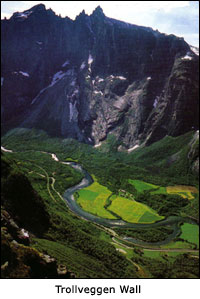
We discovered that we were driving through a river valley feeding into the Romsdalen Fjord. Because the walls of the valley are so steep and because of heavy rains this year, waterfalls spontaneously cascade off the mountainside. This is more spectacular than Yosemite and Denali all rolled into one!
Later we discovered that the sheer granite wall is the highest vertical, overhanging rock face in Europe – some 1000 meters high – Trollveggen. Since we were in Troll country, Trollveggen translates into Troll's Wall. We read on one web travel log, that the location is popular with climbers going up the face of the wall as well as other daredevils who prefer to jump from the top with parachutes. We decided to forego both exciting opportunities!
We stopped at a "Rom" (room) sign and had instant rapport with a couple whose son had attended UC San Diego. We were disappointed that the room had just been taken by another couple. We knew that our instant friendship would be brief, but warm and put off until another time. We ended up camping down the road, with a spectacular view of the Trollveggen.
Lets Talk Roads in Norway!
The Norwegians are master road builders. They blast tunnels through these mountains – some as long as four miles – or they snake them through the valleys along the river beds. OR – why not! – they just zig and zag them up and down the mountain! This road, called Trollstigen or Troll's Road, is supposed to be the ultimate thrill ride, especially for those pulling camping trailers. We learned to read the maps and found gentle meandering river roads for our travel.
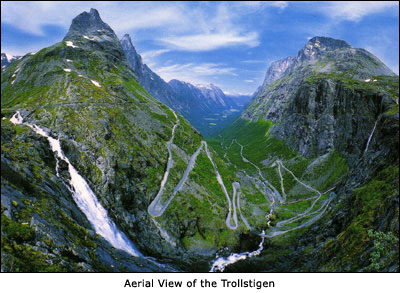
The Trolls
In Norway, the legendary Trolls live under bridges and in the trees and mountains. Do you remember the story of the three Billy Goats Gruff and the Troll who lived under the bridge? That story originated in Norway. Here's what we read about the Trolls:
"In gloomy forest, waterfalls, moonlit lakes, deep fjords and snow-covered mountains, they are to be found, the Trolls.
Some are enormous; others very small. Trolls have only four fingers and toes on each hand and foot, long crooked noses and bushy tails, Trolls are creatures of shadow and darkness: direct sunlight makes them crack and turn to stone.
Trolls live to be several hundred years old. They are ragged and look frightening, but nearly all of them are kind. However, they can be terribly angry, so it's important to stay on the right side of them! Bear that in mind next time you're out and about in the land of Trolls . . ."
And as you can see in the picture below "nearly all of them are kind." They also look a bit like Bill and Sally after a day on the road!

We drove up a peaceful valley that feeds Isfjorden to take a hike and see the old, quiet farm valley from high above. We counted three glaciers creeping down that mountain in the distance. You can't see the telltale blue color of the ice, but it's there. We took our hike on another "toll road" – gravel and dirt, of course – just to the left of that house . . . we decided not to take this shortcut with our car! A leisurely hike satisfied our curiosity.
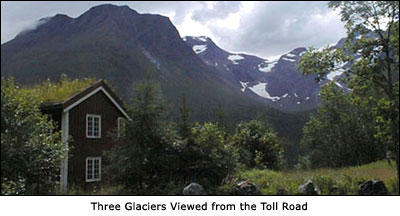
The roads in Norway all seem to end at a ferry crossing. Cars and trucks simply drive to the end of the road, line up to wait for the ferry, and when it arrives, drive on and go! The ferries take campers, milk trucks, logging trucks – you name it. Sally tried to direct the loading of the trucks and campers – she was sure the ferry was going to tip over – but the guys in blue seemed to know what they were doing. We haven't sunk yet.
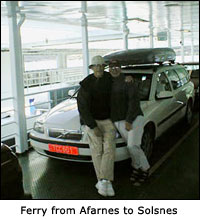 |
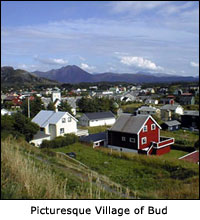 |
The fjords eventually end at the seaside, and the small village of Bud is typical of Norwegian villages. With a total population of 4.5 million people, Norway is one of Europe's least populated countries. Most of the inhabitants are spread out over the country in these small villages and even smaller clusters of homes throughout the farm country.
This remote Kvernes Stave church is actually Norway's newest – a mere 900 years old. It was built in the 1300s. While it is a simple building on the outside, this church is one of Norway's most decorated, with elaborate hand painted paisley swirls on the walls and ceilings. (Sorry no photos inside.) We could see where the colors had been rubbed off by years of worshiping heads leaning against the walls. The poles that appear to be propping up the building, are a mystery – no one seems to know when they were added or what their purpose was.
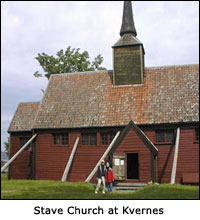 |
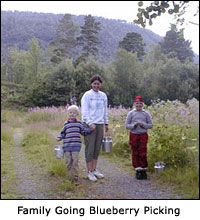 |
While waiting for the ferry to Halsa we spotted this Norwegian family out picking blueberries. "Here, have some," they offered. Once again a brief encounter with what's really important in the world: hold hands, reach out and don't miss the opportunity to share. The berries were delicious, and the Volvo now has a few memorable purple stains.
Another ferry brought us into the colorful harbor of Kristiansund, famous for its kip fishing industry. Legend has it that the villagers got so sick of looking at the color gray (from the large numbers of kip fish drying on the rocks) that they painted their houses bold colors: yellow, blue, red, orange – each neighbor painting his house a different color. The tradition lives on in the colorful houses stacked up the hills overlooking the harbor. The town still supports a fishing industry as well as boat building. We snooped around the old boat repair docks where Bill picked out his favorite sloop.
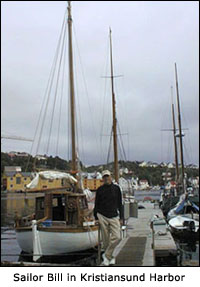 |
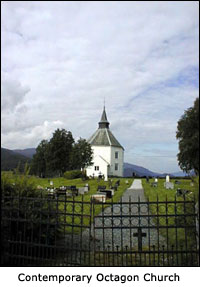 |
Finally we reached the head of the fjord and spotted this 8-sided church built high on a hill overlooking the fjord. The sign outside the gate was in Norwegian, so we were not sure when it was built – perhaps originally in 1100, then rebuilt in 1820. We wandered around the small church, counting the sides. Yes there were eight. Bill noted the simplicity of the headstones, none greater than the others, and one simple cross. Many bore a similar message, "Takk for Alt." We took this to mean, "Thanks for all" or "Thanks to God." One or two simply said, "Takk"
We learned from Rick Steves to look for these "Rom" signs. Norwegian families often rent out rooms – usually with kitchens, private entrances, and a hot shower – for around $45 (2002 exchange rate). This one in the house behind the sign, filled with Norwegian garage sale furnishings, was clean enough and overlooked this beautiful fjord.
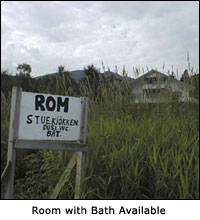 |
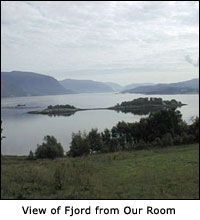 |
Heading north toward Trondheim, we crept along the Strormyra Fjord, on a twisty road that sometimes became just one lane wide. Quite a challenge when you meet a milk truck barreling around the bend in the opposite direction!
Trondheim: Jewel of the North
What a surprise to be 200 miles north of Oslo and find the large cosmopolitan, European city of Trondheim. Sally posed next to this statue of 'everyone's mother'. She was a local who spent her senior years greeting everyone in the town square with a cheery: "Go' dagen" And a good day to you too.
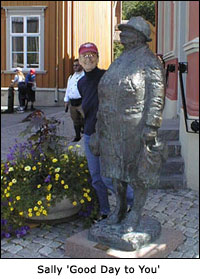 |
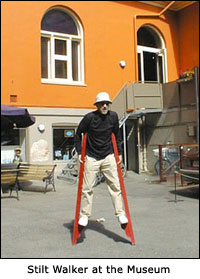 |
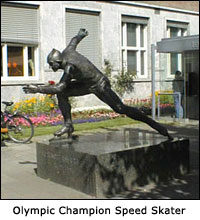
We passed an open courtyard and wandered in to realize we were in the children's activity center of the science museum. Kids were blowing bubbles, challenging themselves to ride bikes built with reverse steering, stilt walking. Just like science museums back home. Bill (very good at stilt walking) is practicing for the 2003 First Night parade.
Who was this Norwegian Olympics champion speed skater? We never found out. For us the sculpture seemed to capture the pride of Norway. Seeing this figure reminded Sally that watching the 1994 Lillehammer Olympics on TV was when she decided she wanted to visit Norway.
Trondheim dates back to the Viking era and at one time was the governmental seat of Norway. It is now undergoing a strong revitalization. These old renovated buildings are painted the most beautiful muted colors: earth brown, mustard, sage, goldenrod, dusty blue. This picture hardly does justice to the scene.
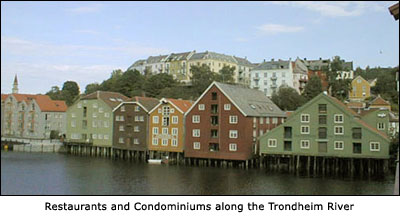
Erkebispegarden – Archbishop's Palace
Built during the 12th century, the massive stone Erkebispegarden – the Archbishop's Palace, was an elaborate series of buildings built around a courtyard, that was occupied until 1537. The archbishops were the rulers during that era, and maintained all the wealth and power, controlling lands and people as far away as Iceland and Scotland. A modern museum across the courtyard houses a treasure chest of archeological finds discovered under the ruins of the buildings, including a complete mint (coin making workshop).
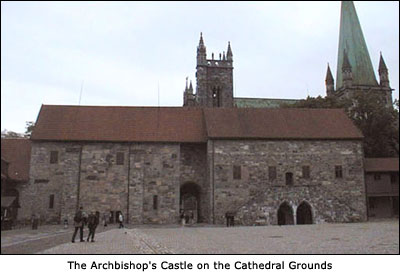
A poet's words greet visitors to this interesting museum:
"The Stone, created by chaos, kissed by the sea, burnt by fire, and gathered here, by ice
The Stone, locking the arch, sealing the gate, lifting cathedrals and building lanes and bridges.
The Stone, summoning the earth to the sky."
Inga E. Naess
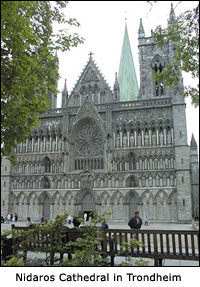
Nidaros Cathedral
Construction of Nidaros Cathedral, one of Scandinavia's oldest and largest medieval buildings, was begun in 1070 and continues today. Repair and redesign have been a part of its 1100 year old history. Very little of it's original stone structure remains. Part Gothic and part Romanesque, it is quite spectacular inside and out. The kings and queens of Norway have been crowned and baptized here.
Princess in the Tower
Sally was first in line behind the tour guide to climb 172 steps to the top of the cathedral tower. The narrow, steep steps curved round and round, constantly upward. This was just like those fairy tales where Sally is Rapunsel, seeking her prince charming. Fifty steps up, the narrow halls seemed to squeeze even tighter and Princess Sally became claustrophobic. "Backup, please", she commanded in English. The entire line of 30 tourists - Germans, Italians, and Brits - had to recede slowly backwards to let her out. "Oh well, Sweetie," Bill consoles "There's never a prince in the tower anyway!"
Bach Organ Concert
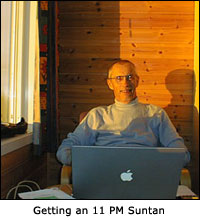
Later that night, we returned to the church for a concert. Two Veggies were in awe as we sat in the great Cathedral, listening to 17th century Bach, played on a massive Baroque organ. The organ, hung high on the cathedral wall, was very elaborate and painted coral, sea foam green and gold leaf – the same colors used in the renovation of Holy Cross church in Santa Cruz. Two angels, one on either side, lift up the massive organ and so that it seemed to float "up to heaven." The experience was a far cry from the hustle and bustle of the tourists and chattering guides earlier in the day.
Back in the hostel as he worked on our next Veggie Gram, Bill watched the cruise ships leave from our window overlooking the harbor. In the land of the midnight sun, we found we could stay up until 2:00 AM, writing, reading and working on our senior tans.
(Yep folks, that's an Apple laptop! The simplicity and elegance of the Macintosh computer make it the desktop platform of choice for most folks who value the intuitive way of doing and being.)
| Veggie Gram Menu | Next Veggie Gram |